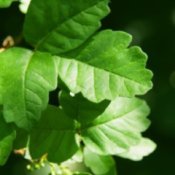 Roundup all the leaves you can. Poison oak usually requires another application, so leave the vine so you can find it again. The more leaves you spray, the better chance you have of getting all of it.
Roundup all the leaves you can. Poison oak usually requires another application, so leave the vine so you can find it again. The more leaves you spray, the better chance you have of getting all of it.
By llpensinger from Ocean City, MD
This page contains the following solutions.
I know what NOT to do. Don't try to burn it. I had a friend try this and she got very sick from inhaling the fumes. I suggest wearing disposable gloves so the oil isn't transferred to anything else.
Here are the questions asked by community members. Read on to see the answers provided by the ThriftyFun community.
I have either poison ivy or poison oak growing all through my forsithia which is all around my yard. My yard is approximately 4 acres. Needless to say, it's too large to wet just the leaves of the poison plants.
Hardiness Zone: 7a
By sheila from Columbus, NJ
Call your county agent extension office they can help you, good luck.
Birds -- they're so helpful in bringing in seeds!
I believe you can get herbicides that you can apply with a brush (included?). I would carefully cut the P.I. near the base and apply the herbicide to the stub. When the upper part of the plant has dried in the sun, carefully (the oils remain in the dead wood) dispose of it.
By the way, forsythias are tough enough that you can cut them nearly to the ground and have them come back. Something to keep in mind as a last resort.
The best way to get rid of poison oak and poison ivy is to get a goat [I am not kidding] , Borrow a goat from a farm and he will eat the poison ivy or poison oak and goatslove it and do not get sick from it , The golf courses in this area know thissecret andsomeeven have their own littlecoral wit a few goats that they let out during the day to graze on the poison ivy so the golfers are not bothered by it , Thisis not ajoke , Borrow a goat for a day . Some farms will rent you one,
These answers do not address three hugh problems with poison oak and ivy:
1. Even though the plants may appear to be dead, after using a spray or in the winter, etc., even the dead branches often have enough dried sap in them to cause rashes. If you want to remove living or dried plants, you must be extremely careful to avoid contact and wear good gloves and possibly even old clothes that you can throw away after a day's work.
2. Exposure to the oils in the plant are what causes the rashes. Another surprize is that washing does not always remove the sap completely. If you wash your hiking gear only, you may react when you next wear it. If you wash your gardening and other clothes with your hiking gear, you may find that your heretofore great clothes are now laced with sap and causing rashes.
3. Many people believe they are not sensitive to the plants. However, these same people realize one day that they are suddenly sensitive to poison oak and ivy after hiking, clearing weeds, etc. This is because each time someone comes into contact with the plants, they build up a little bit of sensitivity and may not realize they are slowly becoming sensitive to the plants. Then, one fine day, their neighbor asks them to remove some poison oak and, surprize, they break out with a hugh rash and may need medical treatment.
Ask me how I know all this?
When trying to eradicate noxious weeds and vines, it may require special methods or products to do this without contaminating the soil. This is a page about killing poison oak without damaging the soil.